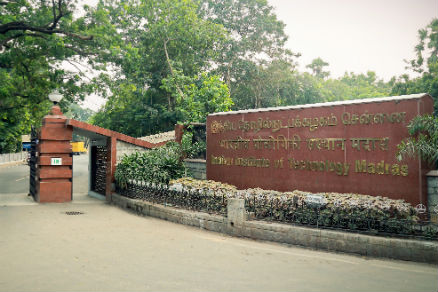IIT Madras Researchers discover new component to effectively split Water into Hydrogen and Oxygen using Solar Power
Chennai: Indian Institute of Technology Madras Researchers have discovered a new material to effectively split Water into Hydrogen and Oxygen using Solar Power. This research is expected to create a renewed interest in solar fuels domain, which can potentially bring the conversion and storage part in a single system, thereby reducing the cost per kWh of solar energy.
A material to be employed in solar fuel generation should be a good photovoltaic material and at the same time remain stable in water medium. The material discovered by IIT Madras Researchers satisfies both the criteria.
Apart from an exciting application perspective, the researchers are seeking to understand the fundamental properties to unravel the material’s electrochemistry in finer details, which is essential for the design of solar fuel devices.
The Solar Energy Research Group (SERG) at IIT Madras, led by Dr. Aravind Kumar Chandiran, Assistant Professor, Department of Chemical Engineering, is specializing in the development of materials and devices architectures for solar cells, solar water splitting to hydrogen fuels, carbon dioxide recycling and metal-air batteries for electric vehicles.
This research paper has been published in the reputed peer-reviewed chemistry journal Angewandte Chemie International Edition. It was co-authored by Dr. Aravind Kumar Chandiran and SERG’s research scholar Mr. Muhammed Hamdan.
Speaking about the practical applications of this Research in the field, Dr. Aravind Kumar Chandiran, Assistant Professor, Department of Chemical Engineering, said, “Storing solar energy in batteries is an expensive business for large scale implementation. A single photoelectrochemical (PEC) system that can harness and store solar energy in the form of chemical fuels can potentially reduce the cost per kWh of energy. Ideally, seawater splitting using PEC to generate clean hydrogen should be a serious research, if India should remain committed to green energy and avoid potential consequences of continued carbon emission. In our recent work, we attempted to make a first successful demonstration of water splitting using the best photovoltaic material.”
Further, Dr. Aravind Kumar Chandiran added, “To date, in the world of halide perovskites, this is the only material that shows such an extraordinary stability in a harsh environment. We are proud that this cutting-edge research at the global level has been undertaken at IIT Madras.”
Solar energy conversion to electricity and their storage at a very low cost is an integral part of renewable energy research, to reduce the world’s reliance on fossil fuels and in turn move out of anthropogenic greenhouse gases like carbon dioxide.
It is an immediate requirement to develop low-cost solar energy conversion and storage systems that can produce energy equal to lower than the cost of grid power. The conventional silicon based solar panels although provide excellent performance and stability, their cost still remains high due to the requirement of extra clean fabrication facility, ultrahigh vacuum and high temperature processes.
In the last two to three decades different solution-processed solar technologies based on dye-sensitization, semiconducting polymers, and quantum dots have come up, however, their performance in the large area devices and stability couldn’t compete with the conventional devices.
In 2009, research community have employed a new class of semiconducting materials, called ‘halide perovskites’ with formula CH3NH3PbI3, for solution processible solar cells. In less than a decade the efficiency of these devices improved from 3% to over 25%. For comparison, the conventional silicon based solar cells took nearly three decades to reach 25% since the certification standards are established by National Renewable Energy Laboratory.
This fast growth of the perovskite based solar cells, however, is significantly limited for commercial scale-up due to the presence of the toxic lead and instability of these devices in ambient conditions. The entire device fabrication has to be carried out in the inert atmosphere, literally under zero oxygen and water to avoid degradation, and they have to be encapsulated to avoid ambient exposure.
To take this technology forward towards commercialization, efforts from research groups across the world have been focused on non-lead and ambient stable halide perovskite absorbers. Several hundreds of research papers were published on improving the robustness of this material in oxygen and humid conditions, by selectively tuning the constituent atoms. However, only a partial ambient stability is being achieved and, these state-of-the-art materials still decompose instantly when they come in contact with water.
The SERG’s research scholar Mr. Muhammed Hamdan, while investigating materials for solar cells, discovered a ‘halide perovskite’ (Cs2PtI6), which completely absorbs the entire visible light and remains extremely stable in ambient. This material is also found to be stable in strong acids and bases.
Mr. Hamdan combined solar energy conversion and storage in the form of chemical fuels by utilizing this material’s record stability. Using sunlight, and with a photoelectrochemical device made with Cs2PtI6, the team was able to successfully split water into hydrogen and oxygen.
The generation of solar fuels is not only restricted to water splitting to generate hydrogen fuel, but our perovskite semiconductors can also be used in carbon dioxide conversion to useful hydrocarbon fuels. In the long run, with the design principles of this material, platinum in Cs2PtI6 can be replaced with other low-cost transition elements to reduce the costs further.

